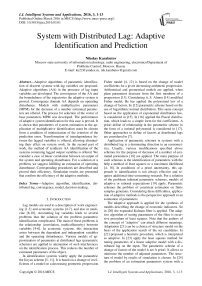System with Distributed Lag: Adaptive Identification and Prediction
Автор: Nikolay Karabutov
Журнал: International Journal of Intelligent Systems and Applications(IJISA) @ijisa
Статья в выпуске: 3 vol.8, 2016 года.
Бесплатный доступ
Adaptive algorithms of parametric identifica-tion of discrete systems with lag variables are proposed. Adaptive algorithms (AA) in the presence of lag input variables are developed. The convergence of the AA and the boundedness of the trajectories the adaptive system is proved. Convergence domain АА depends on operating disturbance. Models with multiplicative parameters (MPM) for the decrease of a number estimated parameters are offered. The process for selection of the vector of base parameters MPM was developed. The performance of adaptive system identification for this case is proved. It is shown that parameters of system estimation at the application of multiplicative identification must be chosen from a condition of minimization of the criterion of the prediction error. Transformation of interdependence be-tween the lagged variables is offered, allowing eliminating their effect on system work. In the second part of work, the method of synthesis АА identification of the systems containing lagged output variables is offered. We consider a case of linear correlation between an output of the system and operating disturbance. For a solution of a problem, we suggest fulfilling an estimation of operating disturbance. Corresponding procedures are described and proved their efficiency. Simulation results are presented that confirm the efficiency of the adaptive methods.
Adaptive algorithm, identification, dis-tributed lag, convergence, model, decision making
Короткий адрес: https://sciup.org/15010800
IDR: 15010800
Список литературы System with Distributed Lag: Adaptive Identification and Prediction
- N. Gershenfeld, The nature of mathematical modelling. Cambridge: Cambridge University Press, 1999.
- T. Kailath, “Linear Least Squares Estimation,” Benchmark Papers in Electrical Engineering and Computer science. Dowden, Hutchinson &Ross, 1977.
- N.N. Karabutov, Structural Identification of Systems. Analysis of Information Structures. Moscow: URSS/ Librokom, 2009.
- E. Malinvaud, Statistical methods in econometrics. 3d ed. Amsterdam: North-Holland Publishing Co. 1980.
- J. Johnston, Econometric methods. 2nd edition. New York: McGraw-Hill Book Company, 1972.
- I.C. Demetriou, E.E. Vassiliou, “An algorithm for distrib-uted lag estimation subject to piecewise monotonic coeffi-cients,” International Journal of Applied Mathematics, 2009, vol. 39, no. 1, pp. 1-10.
- P.J. Dhrymes, Distributed Lags: Problems of Estimation and Formulation. San Francisco: Holden-Day, 1971.
- B. Armstrong, “Models for the relationship between am-bient temperature and daily mortality,” Epidemiology, 2006, 17(6), pp. 624-631.
- C.R. Nelson, G.W. Schwert, “Estimating the parameters of a distributed lag model from cross-section data: the case of hospital admissions and discharges,” Journal of the American Statistical Association, 1974, vol. 69, no. 347, pp. 627-633.
- A. Gasparrini, B. Armstrong, M.G. Kenwardb, “Distribut-ed lag non-linear models,” Statistics in Medicine. 2010, 29(21), pp. 2224–2234.
- L.M. Коуск, Distributed Lags and Investment Analysis. Amsterdsm: North-Holland Publishing Company, 1954.
- Fisher, “Note on a short-cut method for calculating dis-tributed lags,” Bulletin de l’Institut International de Statis-tique, 1937, vol. 29.
- P.J. Dhrymes, L.R. Klein, K. Steiglitz. “Estimation of Distributed Lags,” International Economic Review, 1970, vol. 11, no. 2, pp. 235-250.
- S. Almоn, “The distributed lag between capital appropria-tions and expenditures,” Econometrica, 1965, vol. 33, pp. 178-196.
- H. Theil, R.M. Stern, “A simple unimodal lag distribution,” Metroeconomica, 1960, vol. 12, pp. 111–119.
- R. Solow, “On a family of lag distributions,” Econometrica, 1960, vol. 28, pp. 393-406.
- D.W. Jоrgensоn, “Minimum variance, linear, unbiased seasonal adjustment of economic time series,” Journal of the American Statistical Association, 1964, vol. 59, no. 307, p.p. 681-724.
- W.H. Greene, Econometric analysis, 7th ed. New Jersey: Prentice Hall Pearson Education, Inc., 2012.
- G.C. Chow, “Usefulness of adaptive and rational expecta-tions in economics,” CEPS Working Paper No. 221, Princeton University, 2011.
- J.H. McCulloch, “Adaptive least squares estimation of the time-varying Taylor rule,” 2007. www.econ.ohio-state.edu/jhm/papers/TaylorALS.pdf.
- T.F. Cooley, E.C. Prescott, ”Tests of an Adaptive Regres-sion Model,” The review of economics and statistics, The MIT Press, 1973, vol. 55, no. 2, pp. 248-256.
- R. Butler, J. McDonald, R. Nelson, and S. White, “Robust and Partially Adaptive Estimation of Regression Models,” Review of Economics and Statistics, 1990, 72, pp. 321–327.
- C. Bouveyron, P. Gaubert, J. Jacques, “Adaptive regres-sion models for modeling and understanding evolving populations,” CS-BIGS, 2011, vol. 4(2), pp. 83-92.
- I.C. Demetriou, E.E. Vassiliou, “An algorithm for distrib-uted lag estimation subject to piecewise monotonic coeffi-cients,” International journal of applied mathematics, 2009, vol. 39, no. 1, pp. 1-10.
- N.N. Karabutov, “Structural identification of static systems with distributed lags,” International journal of control science and engineering, 2012, vol. 2, no. 6, pp.136-142.
- N.N. Karabutov, “Structural identification of systems with distributed lag,” International journal of intelligent systems and applications, 2013, vol. 3, no. 11, pp. 1-10.
- N.N. Karabutov, “Adaptive Prediction Model of Tax Indi-cators,” Economy. Taxes. Right, 2014, no. 6, pp. 101-110.
- N.N. Karabutov, Adaptive identification of system: infor-mation synthesis. Moscow: URSS, Komkniga, 2006.
- E.A. Barbashin, Lyapunov Function. Moscow: Nauka, 1970.
- N.R. Draper, H. Smith, Applied regression analysis. Sec-ond edition. New York: John Wiley & Sons, Inc., 1981.
- N.I. Karabutov, V.G. Feklin, “Mathematical models of tax index forecasting,” Economy. Taxes. Right, 2016, no. 6, pp. 115-121.
- N.I. Karabutov, V.G. Feklin, “Forecasting models the volume of overdue debt on loans,” Bulletin Financial University, 20015, no.4, pp. 116-121.


